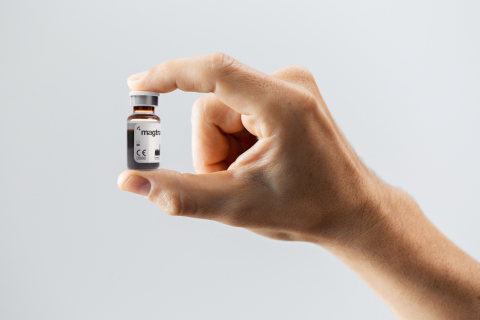The magnetic liquid is the first and only tracer to receive this positive endorsement and allows any patient or hospital to access the highest standard in breast cancer staging, without the need for nuclear facilities or radioisotopes.
NICE’s positive review is a national mark of excellence, informing local NHS planning and decision-makers how to provide better patient care. It was published as part of a Medtech Innovation Briefing commissioned by NHS England in support of the NHS 5-Year Forward View, to accelerate innovation in new treatments and diagnostics.
To determine if breast cancer has spread, doctors analyse the “sentinel”, or nearest, lymph nodes to the tumour to see if they contain cancer cells. Magtrace® helps doctors mark these sentinel nodes by emitting a magnetic signal to guide them to the site of the nodes. Its tiny magnetic particles quickly pass through the lymphatic system and follow the same path a spreading cancer cell would take. It can be injected any time between 20 minutes and 30 days ahead of a sentinel lymph node biopsy, reducing the patients’ time in hospital and enabling the more efficient use of NHS resources.
Commonly, a radioactive isotope, technetium-99m, and blue dye is used to mark sentinel lymph nodes for biopsy. However, when the UK left the European Union in January 2020, it also left Euratom, a commissioning body which governs the use and transport of radioactive material like technetium-99m. Subsequent delays have resulted in some NHS hospitals staging breast cancer with just blue dye, associated with a high false negative rate of 13%, as well as a risk of allergic reaction, or anaphylaxis.2,3
“A sentinel lymph node biopsy is the standard of care for staging early breast cancer and is vital in helping us understand whether cancer has spread,” explains Kate Williams, Consultant Oncoplastic Breast Surgeon at North Manchester General Hospital, Manchester Foundation Trust, and one of the experts that contributed to Magtrace’s NICE’s briefing. “It’s concerning to hear that women with breast cancer are having this procedure with substandard techniques when there are non-radioactive alternatives like Magtrace, ready and available.”
Unlike technetium-99m, the Magtrace® lymphatic tracer is manufactured in the UK and requires no nuclear facilities to be stored or used. It is also well-tolerated and carries no risk of allergic reactions.3 As the UK Government works to address the cancer backlog seen as a result of the pandemic, and to fulfil its promise to ‘level-up’ its commitment to UK science and technology, Endomag’s Magtrace® could play a vital role in supporting the healthcare system to tackle the challenges seen with the current standard of breast cancer care.
“Breast cancer is better understood than any other cancer today. And yet, the need for innovation has never been greater, as so many patients have been missed during the pandemic. We feel more determined than ever to make a difference after this NICE positive review, which confirms that innovative UK technologies like the Magtrace marker can play a role to help the health system continue staging breast cancer,” said Eric Mayes, CEO, Endomag.
To compile its Medtech Innovation Briefing, NICE obtained feedback from clinical experts who all agreed that the Magtrace® lymphatic tracer’s magnetic mechanism of action was a key innovative feature. Magtrace® has been shown to be non-inferior to technetium-99m and blue dye in numerous clinical trials involving over 5,000 patients.
In total, over 160,000 women across more than 600 hospitals in 40 countries have already been able to access more precise and less invasive breast cancer treatment thanks to Endomag’s technologies. Endomag welcomes NICE’s positive review of the Magtrace® lymphatic tracer and will continue to work to support access and improve standards of care for all breast cancer patients.
